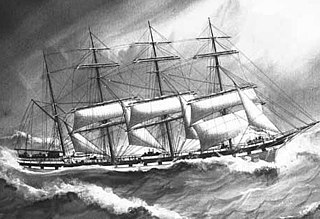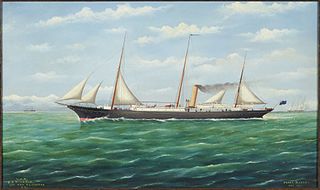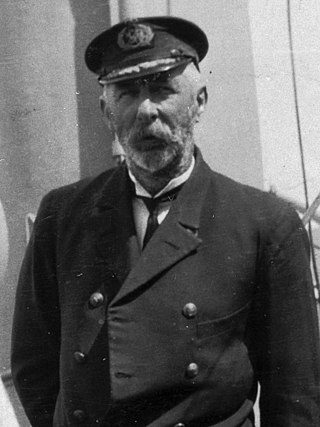Related Research Articles

The Auckland Islands are an archipelago of New Zealand, lying 465 km (289 mi) south of the South Island. The main Auckland Island, occupying 460 km2 (180 sq mi), is surrounded by smaller Adams Island, Enderby Island, Disappointment Island, Ewing Island, Rose Island, Dundas Island, and Green Island, with a combined area of 570 km2 (220 sq mi). The islands have no permanent human inhabitants.

The Lexington was a paddlewheel steamboat operating along the Northeastern coast of the United States from 1835 to 1840. Commissioned by Cornelius Vanderbilt, it was one of the fastest and most luxurious steamers in operation.

A chief mate (C/M) or chief officer, usually also synonymous with the first mate or first officer, is a licensed mariner and head of the deck department of a merchant ship. The chief mate is customarily a watchstander and is in charge of the ship's cargo and deck crew. The actual title used will vary by ship's employment, by type of ship, by nationality, and by trade: for instance, chief mate is not usually used in the Commonwealth, although chief officer and first mate are; on passenger ships, the first officer may be a separate position from that of the chief officer that is junior to the latter.

General Grant was a 1,005-ton three-masted bark built in Maine in the United States in 1864 and registered in Boston, Massachusetts. It was named after Ulysses S. Grant and owned by Messers Boyes, Richardson & Co. She had a timber hull with a length of 179.5 ft, beam of 34.5 ft and depth of 21.5 ft. While on her way from Melbourne to London, General Grant crashed into a cliff on the west coast of main island of the Auckland Islands of New Zealand, and subsequently sank as a result. Sixty-eight people drowned and only 15 people survived.

The Farallon Steamship Disaster was the wreck of a wooden Alaska Steamship Company passenger liner, SS Farallon, that hit Black Reef in Cook Inlet in the Territory of Alaska on 5 January 1910. All on board evacuated to a nearby island, where most had to survive for a month in a mid-winter climate before they were rescued. Six other survivors survived an attempt to row across Shelikof Strait in search of rescue for the stranded men.
Seafaring is a tradition that encompasses a variety of professions and ranks. Each of these roles carries unique responsibilities that are integral to the successful operation of a seafaring vessel. A ship's crew can generally be divided into four main categories: the deck department, the engineering department, the steward's department, and other. The reasoning behind this is that a ship's bridge, filled with sophisticated navigational equipment, requires skills differing from those used on deck operations – such as berthing, cargo and/or military devices – which in turn requires skills different from those used in a ship's engine room and propulsion, and so on.

Dundonald was a British four-masted steel barque measuring 2,205 gross register tons launched in Belfast in 1891. It was involved in a wreck in 1907 in the New Zealand Subantarctic Islands. Only 15 of its 28 crew survived; they were rescued seven months later by a scientific expedition.

HMAS Woomera was an Australian naval vessel operated by the Australian Army and Royal Australian Navy (RAN). Built in Fremantle, Western Australia, she was one of a class of 32 wooden motor vessels intended for the Department of Commerce, but later allocated to the Army. She initially entered service in late 1945 as AV 1356 (Ashburton), before being transferred to the RAN on 23 January 1946 and commissioned as Woomera. The ship's main role was carrying stores and dumping obsolete ammunition surplus from all three military services at sea. In this role she visited many ports in Australia and New Guinea.

Carnley Harbour is a large natural harbour in the south of the Auckland Islands, part of the New Zealand Subantarctic Islands. Formed from the drowned crater of an extinct volcano, the harbour separates the mainland of Auckland Island to the north, from the smaller Adams Island in the south. The harbour is sometimes referred to as the Adams Straits.

A castaway depot is a store or hut placed on an isolated island to provide emergency supplies and relief for castaways and victims of shipwrecks.
The Derry Castle was a 1,367 ton iron barque built at Glasgow in 1883, and initially operating out of Limerick, Ireland. She had been registered there on 19 November 1883 by Francis Spaight & Sons. In 1887 while voyaging from Australia to the United Kingdom with a cargo of wheat, she foundered off Enderby Island, in the subantarctic Auckland Islands, on a reef which now bears her name.

NZGSS Hinemoa was a 542-ton New Zealand Government Service Steamer designed specifically for lighthouse support and servicing, and also for patrolling New Zealand's coastline and carrying out castaway checks and searching for missing ships. It operated in New Zealand's territorial waters from 1876 to 1944.

John Peter Bollons was a New Zealand marine captain, naturalist and ethnographer. For many years he captained New Zealand government steamers, including the NZGSS Hinemoa, which undertook lighthouse work and patrols through New Zealand's subantarctic islands. Bollons Island, in the Antipodes Islands, is named after him. In 1928 he was appointed a Companion of the Imperial Service Order.
Grafton was a 56-ton schooner sailing out of Sydney during the 1860s that was wrecked on 3 January 1864 in the north arm of Carnley Harbour, Auckland Island, one of the New Zealand Subantarctic Islands, nearly 480 kilometres (300 mi) south of the South Island. Her castaway crew waited a year for a ship to come to their rescue, which, it soon became apparent, would not come. Six months later, three men decided to set out in a dinghy and managed to cross a distance of 450 kilometres (280 mi) to Stewart Island, 30 kilometres (20 mi) south of New Zealand's South Island. They then funded a rescue mission to pick up their remaining companions. The crew spent a total of 18 months on the sub-Antarctic island and, despite their ordeal, all survived.
The Invercauld was an 1,100-ton sailing vessel that was wrecked on the Auckland Islands in 1864.

The Sub-Antarctic Islands Scientific Expedition of 1907 was organised by the Philosophical Institute of Canterbury. The main aim of the expedition was to extend the magnetic survey of New Zealand by investigating Campbell Island and the Auckland Islands, but botanical, biological and zoological surveys were also conducted.
Anjou was a 1,642 gross register tons (GRT), French steel barque built in 1899. It was wrecked in the Auckland Islands in 1905.
Spirit of the Dawn was a British 692-ton iron barque that wrecked in the Antipodes Islands on 4 September 1893. She was built at Sunderland in 1869 by T. R. Oswald and Co. and owned by J. Bell and Son of Liverpool.

The Queen Bee was a ship, constructed in Sunderland and launched in 1859. It was used primarily for transporting immigrants from England to New Zealand, having made about 11 journeys before grounding on Farewell Spit in 1877.

Assaye was a barque that was lost with all 25 hands on a voyage from London to Wellington, New Zealand in 1890.
References
- 1 2 3 4 "Wreck of the Compadre". Grey River Argus. Greymouth. 7 July 1891. Retrieved 23 December 2018.
- ↑ "A Rescued Crew". The Star . Christchurch. 7 July 1891. Retrieved 23 December 2018.
- ↑ "Rescue of Castaways". Otago Witness . Dunedin. 9 July 1891. Retrieved 23 December 2018.
- 1 2 Eden, A. W. "The wrecks of the Invercauld and the Compadre". Islands of Despair. London: Andrew Melrose. OCLC 165050785.
- 1 2 3 4 5 "Loss of Barque Compadre". The Southland Times . Invercargill. 10 July 1891. Retrieved 23 December 2018.
- ↑ "Hinemoa could have made but an indifferent search". North Otago Times . 8 July 1891. Retrieved 23 December 2018.